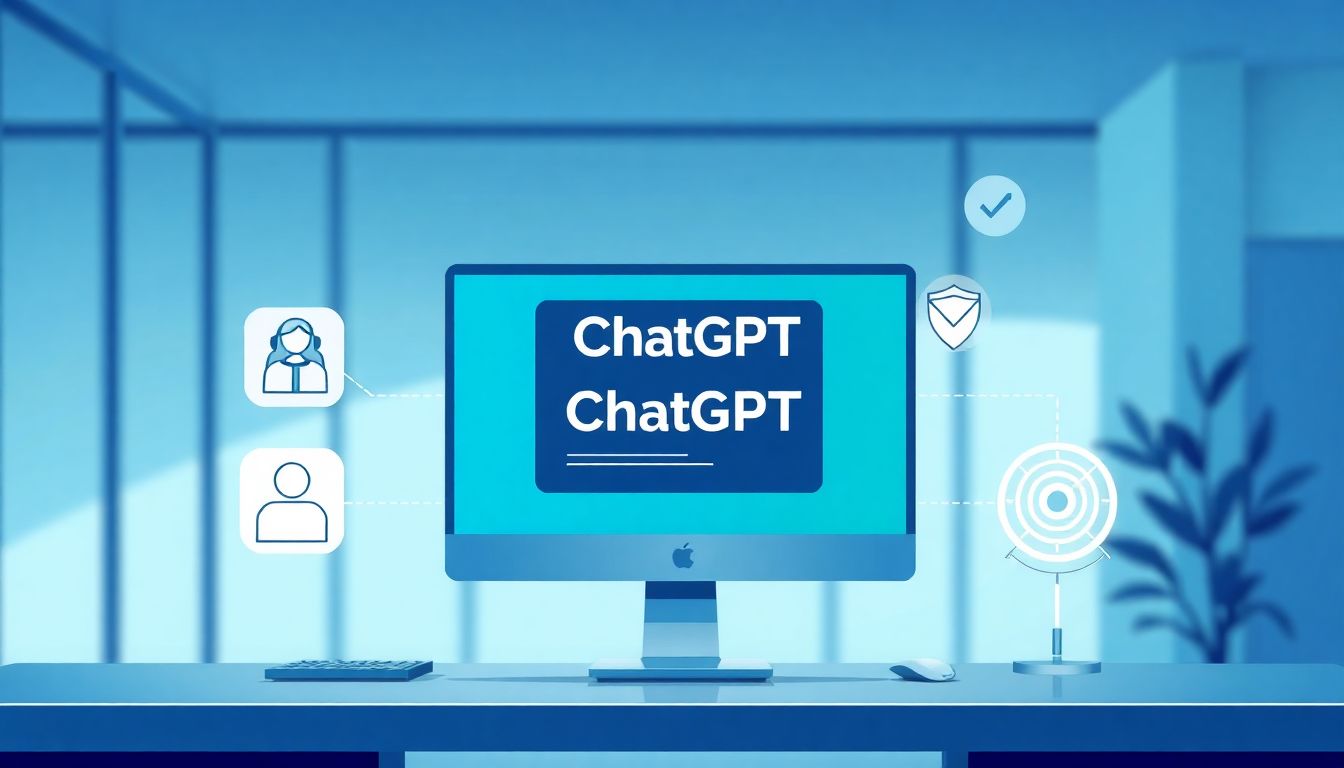Are you feeling stuck trying to find ways to innovate your business model? You’re not alone! Many entrepreneurs struggle with keeping their offerings fresh and relevant in a fast-paced world.
But what if I told you that ChatGPT could be your secret weapon? Stick around, and I’ll show you how leveraging this advanced AI can unlock creative solutions and streamlined processes to elevate your business.
We’ll explore practical steps, inspiring examples, and tips to overcome challenges, so you can stay ahead of the curve and make your business thrive with ChatGPT!
Key Takeaways
- ChatGPT can help innovate your business model by generating creative strategies tailored to your core values.
- Successful companies like Replica and Kuki show real-world applications of ChatGPT enhancing customer engagement and service delivery.
- Identify specific uses for ChatGPT, like improving customer support or marketing content, for better integration.
- Advantages include boosted creativity, improved efficiency, enhanced customer interactions, and cost reductions.
- Address challenges like team resistance and data privacy proactively to ensure smooth integration.
- Regularly review ChatGPT outputs and encourage experimentation among team members for optimal results.
- Future trends include predictive analytics and AI-driven decision-making, allowing for more tailored customer experiences.

How to Use ChatGPT to Create Innovative Business Models
Using ChatGPT to create innovative business models can really transform how you approach your strategy.
First off, identify the core values of your business and how AI technology can augment these values.
Consider prompts like:
- “Suggest three innovative business strategies that incorporate AI technology”
- “Outline unique business model options that leverage ChatGPT capabilities for customer engagement”
- “Describe how AI can redefine our current business strategy for improved efficiency”
Next, experiment with different scenarios where ChatGPT could assist in product development or service enhancement.
Involve ChatGPT in brainstorming sessions or use it to simulate customer interactions, gaining insights into preferences.
Finally, continuously iterate on your ideas based on feedback derived from ChatGPT’s analyses or suggestions.
Examples of Business Models Enhanced by ChatGPT
Several successful companies have already harnessed ChatGPT to improve their business models.
Take a look at startups like Replica, which utilizes AI to create personalized customer experiences.
They’ve streamlined their communication and significantly enhanced user engagement.
Another great example is Kuki, a chatbot that creates unique interaction pathways for users, utilizing AI to enhance service delivery.
To illustrate further, consider prompts like:
- “Provide case studies of businesses successfully integrating ChatGPT into their services”
- “List three real-life examples where ChatGPT innovation enhanced business performance”
- “Summarize how AI-driven business models have flourished in recent years”
These examples show real-world applications of ChatGPT that lead to quicker decision-making and better customer relations.
Step-by-Step Guide to Implementing ChatGPT in Your Business Model
Implementing ChatGPT into your business model doesn’t need to be overwhelming.
Start by defining specific use cases where ChatGPT can provide the most value.
For instance, you might want to enhance customer support or improve content generation for marketing.
Second, choose your platform and integrate ChatGPT smoothly with existing tools.
Consider prompts like:
- “Guide me through the step-by-step process to effectively implement ChatGPT”
- “What guidelines should I follow to integrate ChatGPT into our customer service operations?”
- “Outline a plan for utilizing ChatGPT to enhance our marketing efforts”
Next, test the model with real users to gather feedback and make necessary adjustments.
Lastly, monitor the performance regularly to ensure the business model achieves its intended goals.
Benefits of Using ChatGPT for Business Innovation
Integrating ChatGPT into your business model comes with numerous advantages.
For starters, it enhances creativity by generating diverse ideas tailored to your business needs.
It can also improve efficiency, drastically reducing the time spent on tasks like content creation or data analysis.
Additionally, ChatGPT helps with customer engagement by providing personalized interactions that resonate with users.
To get specific insights, consider prompts like:
- “Describe the benefits of using AI tools in business operations”
- “List five advantages that ChatGPT offers for small businesses”
- “How does ChatGPT enhance customer engagement and satisfaction in different industries?”
Cost reduction is another strong point; automating various tasks can free up valuable resources for other areas of your business.
Ultimately, using ChatGPT not only boosts innovation but also paves the way for sustainable business growth.

Common Challenges When Integrating ChatGPT into Business Models
Integrating ChatGPT into business models presents a set of unique challenges that organizations must navigate.
One primary obstacle is the resistance to change among team members who may be skeptical about AI technology.
To overcome this resistance, it’s crucial to provide training sessions that highlight the benefits of using ChatGPT.
Another challenge is ensuring data privacy and compliance, which is essential when handling customer information.
Create a clear privacy policy and engage in responsible data management practices to ease these concerns.
Consider prompts like:
- “Identify potential resistance areas when introducing ChatGPT in our business”
- “Outline steps to ensure data privacy while using AI tools”
- “What are common pitfalls businesses face when integrating ChatGPT?”
Technical hurdles can also arise during implementation, especially if there’s a lack of adequate infrastructure.
Conduct a thorough assessment of your current systems to identify any gaps that need addressing.
Additionally, ensuring alignment between ChatGPT’s capabilities and your business goals is essential for a successful integration.
Closing this gap ensures ChatGPT serves a purpose rather than just being an added feature.
Tips for Getting the Most Out of ChatGPT in Your Business
To truly maximize ChatGPT’s potential, adopting best practices is key.
Start by defining clear objectives for what you want to achieve with ChatGPT integration.
This might be improved customer service or more engaging content marketing.
Leverage prompts to guide ChatGPT toward understanding your needs better:
- “List specific objectives for using ChatGPT in our business”
- “Create a strategy for improving our customer engagement with AI tools”
- “How can we enhance our content marketing efforts using ChatGPT?”
Regularly review the outputs from ChatGPT to assess quality and relevance.
Feedback is essential; sharing insights with your team can highlight areas for improvement.
Encourage team members to experiment with different prompts and approaches, which can lead to fresh ideas.
Set aside time for brainstorming sessions where ChatGPT can facilitate creative thinking.
Lastly, stay updated on AI advancements and enhancements relevant to ChatGPT.
Incorporating the latest features can lead to discovering new capabilities that can enrich your business model.
Future Trends in Business Models with ChatGPT
The future of business models is promising, especially with continued advancements in AI technology like ChatGPT.
One emerging trend is the utilization of predictive analytics powered by AI, which helps companies forecast consumer behavior.
This allows businesses to tailor their strategies more effectively to meet customer needs.
Incorporate prompts to explore these future applications:
- “What are future trends influencing AI in business?”
- “Predict how ChatGPT can evolve business interactions over the next decade”
- “Summarize how predictive analytics can enhance our business model with ChatGPT”
Another direction is the rise of AI-driven decision-making processes.
Organizations will increasingly rely on data-driven insights generated by ChatGPT to make informed strategic choices.
As businesses become more adaptable, we can expect more personalized customer experiences fabricated through AI interactions.
Networking with other innovators in the field can provide insights into how to implement these trends in real-time.
Ultimately, staying proactive in leveraging ChatGPT will prepare businesses to thrive in an evolving landscape.

Common Challenges When Integrating ChatGPT into Business Models
Integrating ChatGPT into business models can come with its share of hurdles.
One significant challenge is the resistance to change among team members who might be apprehensive about adopting new technology.
Overcome this by organizing training and demonstrations that showcase ChatGPT’s benefits.
Another issue is data privacy and compliance, which is a critical concern when dealing with customer data.
Ensure a solid data governance policy is in place to address these aspects and reassure your customers.
Consider using prompts like:
- “Identify potential resistance areas when introducing ChatGPT in our business”
- “Outline steps to ensure data privacy while using AI tools”
- “What are common pitfalls businesses face when integrating ChatGPT?”
Technical difficulties can also arise, particularly if your existing infrastructure isn’t compatible.
Evaluate your current systems to see what adjustments need to be made for a smoother integration.
Lastly, ensuring that ChatGPT’s capabilities align with your business goals is crucial for effective utilization.
This alignment helps to ensure that ChatGPT adds value rather than just complexity to your operations.
Tips for Getting the Most Out of ChatGPT in Your Business
Maximizing the effectiveness of ChatGPT in your business means implementing some best practices.
First, define precise objectives for your integration efforts.
This clarity could focus on aspects like enhancing customer service or refining your content strategy.
Think about using prompts such as:
- “List specific objectives for using ChatGPT in our business”
- “Create a strategy for improving customer engagement with AI tools”
- “How can we enhance our content marketing efforts using ChatGPT?”
Regularly assess the outputs from ChatGPT for quality and relevance; this helps in maintaining high standards.
Feedback is vital, so engage your team in discussions about the results and how they can be improved.
Encourage your team members to explore different prompts and ideas, as this experimentation can lead to innovative solutions.
Consider scheduling brainstorming sessions with ChatGPT to spark creativity and fresh concepts.
Finally, stay informed about the latest advancements in AI technology.
Keeping up-to-date can unearth new functions within ChatGPT to enhance your business model.
Future Trends in Business Models with ChatGPT
The future of business models intertwined with AI like ChatGPT looks quite promising.
One notable trend is the increased use of predictive analytics powered by AI.
This capability helps businesses better understand consumer behavior, which allows for more tailored strategies.
Utilize prompts to dig deeper into future applications:
- “What are future trends influencing AI in business?”
- “Predict how ChatGPT can evolve business interactions over the next decade”
- “Summarize how predictive analytics can enhance our business model with ChatGPT”
Another trend is the transition towards AI-driven decision-making processes.
More companies are leaning on data-based insights from ChatGPT to guide their strategic choices.
As adaptability becomes key, expect customer experiences to become more personalized through interactions powered by ChatGPT.
Networking with innovators in the AI space can yield valuable insights into real-time implementation of these trends.
Embracing ChatGPT proactive measures will position your business for success amid evolving landscapes.
FAQs
ChatGPT can analyze trends, generate ideas, and provide insights into customer preferences, helping businesses brainstorm and refine innovative business models tailored to market needs.
Examples include personalized customer support systems, subscription-based models leveraging AI for content generation, and data analytics services that use ChatGPT for market predictions.
Challenges include data privacy concerns, ensuring accurate outputs, integrating with existing systems, and managing user expectations regarding AI capabilities.
Companies should define clear goals, provide quality inputs, offer continuous training for the AI, and regularly evaluate outputs to enhance the effectiveness of ChatGPT.
